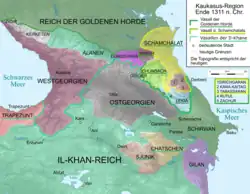Kingdom of Western Georgia დასავლეთ საქართველოს სამეფო dasavlet sakartvelos samepo | |||||||||
|---|---|---|---|---|---|---|---|---|---|
| 1259–1330 1387–1392 1396–1401 | |||||||||
 Map of fragmented Kingdom of Georgia in 1311, with western realm in purple. | |||||||||
| Capital | Kutaisi | ||||||||
| Common languages | Middle Georgian | ||||||||
| Religion | Eastern Orthodox Christianity (Georgian Patriarchate) | ||||||||
| Government | Feudal monarchy | ||||||||
| Historical era | Late Middle Ages | ||||||||
| |||||||||
| Part of a series on the |
| History of Georgia |
|---|
.jpg.webp) |
The Kingdom of Western Georgia (Georgian: დასავლეთ საქართველოს სამეფო, romanized: dasavlet sakartvelos samepo) was a late medieval de facto independent fragmented part[1][2] of the Kingdom of Georgia that emerged during the Mongol invasions of the realm, led by King David VI Narin in 1259[3][4] and later followed by his successors. Over the decades, the monarchy would fall into chaos and transform into a federation of autonomous principalities unruly of the central or regional royal power and authority.
Most of the occasions, realm would be reannexed into unified fold by the eastern Georgian kings. Nevertheless, the unified Georgian realm would de jure collapse in 1490,[5] and western Georgia would secure an independent future under the name of Kingdom of Imereti, that will exist til 1810.[6]
Name of the realm
The question of the contemporaneous name of the realm between 1259 and the early 1400s remains without a concrete answer because from the end of the 15th century, Western Georgia extended from the modern-day city of Sochi in the north[7] to Trebizond in the south and the Likhi Range in the east. The chronology of the adoption of this name for this state is not clear and it is plausible that some monarchs before 1490[8] fragmentation would style themselves as "Kings of Imereti", however, it may well be an anachronism and that an actual change of the title would happen much later.[9]
Indeed, upon 1259 independence pushed by King David VI Narin, he would continue to be styled as David VI, king of united Georgia. Modern historians, such as the former head of the historical department of the Tbilisi State University, Professor Nodar Asatiani justifies the naming of the realm as the Kingdom of Western Georgia until the 15th century, demonstrating that the rulers of that fragmented state considered themselves a legitimate line of the Georgian kings who protected the Georgian nation during the Muslim invasions and were fiercely fighting for the unity.[10] French historian Marie-Félicité Brosset also attributes the creation of the distinctive kingdom of Imereti under that name to the first coronation of King Bagrat VI in 1463.[11]
List of kings
- David VI Narin, 1259-1293
- Constantine I (son), 1293-1327
- Michael (brother), 1327-1329
- Bagrat I (son), 1329-1330
1330-1386: Reunification of Georgia
- Alexander I (son of Bagrat I), 1387-1389
- George I (brother), 1389-1392
1392-1396: Reunification of Georgia
- Constantine II (son of Bagrat I), 1396-1401
References
Bibliography
- Brosset, Marie-Félicité (1849) Histoire de la Géorgie, depuis l'Antiquité jusqu'au XIXe siècle - 1re partie, Saint Petersburg Academy of Sciences
- Brosset, Marie-Félicité (1856) Histoire de la Géorgie depuis l'Antiquité jusqu'au XIXe siècle, Histoire moderne II, Saint Petersburg Academy of Sciences, ISBN 978-0-543-94480-1.
- Rayfield, Donald (2012) Edge of Empires, a History of Georgia. Londres: Reaktion Books. ISBN 978-1-78023-070-2.
- Frédéric Dubois de Montpéreux (1999) Voyage autour du Caucase, chez les Tcherkesses et les Abkhazes, en Colchide, en Géorgie, en Arménie et en Crimée, Volume 1, Soukhoumi, Adegi Graphics LLC, ISBN 1-4212-4702-X